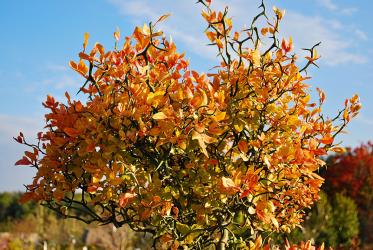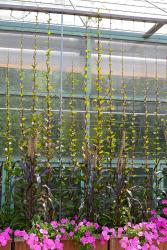That old saying about there being nothing new under the sun may just be coming true under the sun in your back yard. Back in Medieval times monks combined flowers, vegetables and medicinal herbs in the gardens surrounding their monasteries. The French coined the term “portage” to describe formally laid out kitchen gardens that mixed flowers, vegetables and fruits in ways that were beautiful as well as useful.
Dial up a few centuries and here we go again with gardeners wanting the flowers that make their landscapes colorful and beautiful but also with a yen to pick something from the garden they can serve up for dinner.
It is all part of the “healthy is wealthy” trend that has people increasingly valuing diet and exercise as keys to a happy life, notes Tom Mee, retail manager for Frisella Nursery in Defiance. “For at least the past 10 years people have become more and more interested in where their food is coming from,” he adds, noting the popularity of local farmer’s markets and organic produce. “Growing your own produce is the next evolution of that idea.”
With most homeowners having limited space and only so many sunny spots in their gardens, the only way to have flowers, fruits and vegetables is to put them in the same landscape plot. When doing this, the most important consideration, Tom points out, is to make sure the flowers, fruits and vegetables you are inter-planting have the same sun, soil and moisture requirements. Flowers can actually have a beneficial effect on edibles by attracting additional pollinators to garden and thereby increasing yield of fruits and vegetables.
There are a myriad of ways to add attractive edibles to garden beds. Leaf lettuce in a variety of shapes and colors can make a fine edging; so can low-growing, creeping thyme. Multi-colored peppers can add beauty as well as provide a nice harvest. Beans can climb a trellis as easily as roses and mandevilla vines.
While some combinations come easily to mind, Tom suggests also thinking outside the box. Here are some of his suggestions. While many gardeners consider boxwood a landscaping staple, blueberry bushes are slow growing and mature to a 3-foot by 3-foot size, the same as many boxwoods. While they are not evergreen, they do provide luscious berries and have beautiful fall color.
Malabar spinach, while not a true spinach, thrives in the heat when regular spinach is out of season. With lush, dark-green, arrow-shaped leaves and reddish-purple stems, it climbs trellises and fences and also works well in containers. The leaves have a mild, grassy taste and are wonderful in salads and also can be cooked.
Flying Dragon Hardy Orange has beautiful fall color in addition to producing golf ball-sized, hard, bitter fruit that can be candied and made into marmalade. The peel also can be grated for orange zest, Tom notes. There are fruit trees perfect for small gardens and patio spaces. Colonnade apple grows 8 to 10 feet tall but only 2 feet wide and produces fruit. Apple, pear and cherry trees also can be espaliered (pruned to be two-dimensional and grow flat against a wall) and be decorative as well as fruit producing.
This just may be the year to pick produce from your own beautiful garden.
Resources
Frisella Nursery, 636-798-2555







